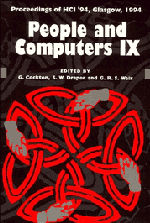Book contents
- Frontmatter
- Contents
- Preface: HCI'94 – You Probably Haven't Seen It All Before
- Part I Invited Papers
- Part II Methodology of Interactive Systems Development
- 3 Transferring HCI Modelling and Design Techniques to Practitioners: A Framework and Empirical Work
- 4 The Use of Visual Indexing as an Interview Support Technique
- 5 A Domain Analysis of Air Traffic Management Work can be Used to Rationalise Interface Design Issues
- 6 Manuals as Structured Programs
- 7 Improving Education through Computer-Based Alternative Assessment Methods
- 8 Visual Programming in a Visual Domain: A Case Study of Cognitive Dimensions
- 9 Evaluating Evaluation Methods
- Crafting Interaction: Styles, Metaphors, Modalities and Agents
- Modelling Humans, Computers and their Interaction
- Notations and Tools for Design
- Part VI Computer-Supported Cooperative Work
- Author Index
- Keyword Index
4 - The Use of Visual Indexing as an Interview Support Technique
Published online by Cambridge University Press: 04 August 2010
- Frontmatter
- Contents
- Preface: HCI'94 – You Probably Haven't Seen It All Before
- Part I Invited Papers
- Part II Methodology of Interactive Systems Development
- 3 Transferring HCI Modelling and Design Techniques to Practitioners: A Framework and Empirical Work
- 4 The Use of Visual Indexing as an Interview Support Technique
- 5 A Domain Analysis of Air Traffic Management Work can be Used to Rationalise Interface Design Issues
- 6 Manuals as Structured Programs
- 7 Improving Education through Computer-Based Alternative Assessment Methods
- 8 Visual Programming in a Visual Domain: A Case Study of Cognitive Dimensions
- 9 Evaluating Evaluation Methods
- Crafting Interaction: Styles, Metaphors, Modalities and Agents
- Modelling Humans, Computers and their Interaction
- Notations and Tools for Design
- Part VI Computer-Supported Cooperative Work
- Author Index
- Keyword Index
Summary
Systems analysts have a number of techniques at their disposal when capturing or generating the requirements for a system. One of the most commonly used is the interview. Interviewing users and other members of the client organisation is often fraught with difficulty: social and communicational barriers may prove difficult to overcome, especially if the level of contact between developers and users is kept to a minimum. Poor interview technique, ignorance of incorrect implicit/unspoken assumptions and the misinterpretation of interview data can lead to incorrect requirements or incomplete specifications. This paper describes a technique for developing a collaborative visual representation of information gathered during the interview process which enhances understanding between participants and enriches the information gathered. The method combines the manipulation of graphical objects and informal discussions which are collected via cassette or video recording. Graphical representation objects — representing the groups, procedures, tools and products that exist in the interviewee's experience — provide a standard, structured means of visual expression. Recording of walkthroughs and discussions of the results keeps note-making to a minimum and helps to reduce the social distance between the participants. A description of the four main stages of the technique is presented, along with supporting material outlining reasons why the technique was developed and describing how it has been used on organisational case studies. The paper concludes with an assessment of the effectiveness of the technique and suggests how it could be tailored to support requirements capture for system design.
Keywords: problems in communication, interviews, visual thinking, visual description, system design.
Introduction
This paper describes an interview technique that was developed in an attempt to solve the problems generated by the possibility of communication barriers between analysts and domain experts.
- Type
- Chapter
- Information
- People and Computers , pp. 37 - 52Publisher: Cambridge University PressPrint publication year: 1994

